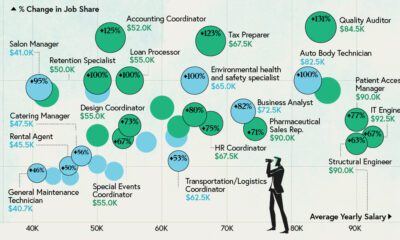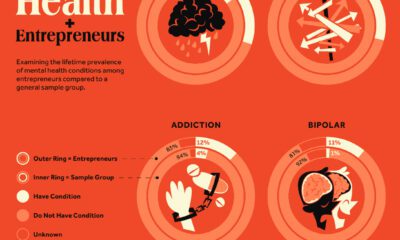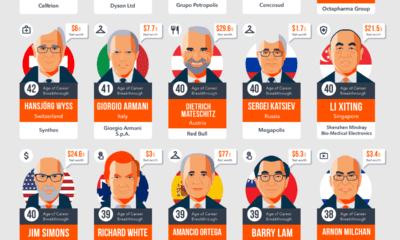Misc
Emotional Intelligence: A Hidden Key to Career and Workplace Success
When the term “intelligence” comes up in regular conversation, most of us associate it with a person’s capacity to acquire knowledge and new skills.
This type of intelligence can be measured with IQ, which helps us determine if the test taker is closer to a Stephen Hawking or a Lloyd Christmas on the smarts scale. And certainly, given no other data, a hiring manager would likely prefer to choose someone on the Hawking end of the spectrum.
But while IQ is useful, it’s also clear that emotional intelligence (EQ) can be a difference maker in any professional role.
Defining Emotional Intelligence
Have you ever met an entrepreneur with so much empathy and awareness, that they can read people in every situation and relate? Or a salesperson that will always genuinely put your success ahead of their own personal gain?
These are powerful qualities – and emotional intelligence is all about the ability to better navigate social situations, including with colleagues, bosses, and clients.
Today’s infographic comes from Aumann Bender & Associates, and it defines emotional intelligence while explaining the benefits of higher EQ in both qualitative and quantitative terms.

Even if someone is smart in terms of IQ, it doesn’t necessarily translate to career success.
In fact, emotional intelligence explains why 70% of the time, a person with an average IQ can actually outperform a person with more smarts.
Quantifying EQ
Although the topic of emotional intelligence may seem “touchy-feely” for some, the benefits of having a higher EQ are cold, hard facts to ponder:
- A whopping 90% of top performers have high EQs
- Emotional intelligence explains 58% of a leader’s job performance
- People with higher EQs make an average of $29,000 more per year than people with lower EQs
- Every one-point increase in EQ equates roughly to $1,300 in annual salary
- Research shows that EQ is crucial across all industries and sectors
So the next time you’re looking at how to get an edge at the workplace, consider that it’s not just knowledge or skills that you should be after.
Sometimes there is a higher ROI in the “soft skills”: being more self-aware, learning how to effectively express your opinions or emotions, finding ways to bounce back from adversity, or managing stress or negative emotions can be more important than technical skills in improving career performance.
Misc
Visualizing the Most Common Pets in the U.S.
Lions, tigers, and bears, oh my!—these animals do not feature on this list of popular American household pets.

Visualizing The Most Common Pets in the U.S.
This was originally posted on our Voronoi app. Download the app for free on iOS or Android and discover incredible data-driven charts from a variety of trusted sources.
In this graphic, we visualized the most common American household pets, based on 2023-2024 data from the American Pet Products Association (accessed via Forbes Advisor).
Figures represent the number of households that own each pet type, rather than the actual number of each animal. The “small animal” category includes hamsters, gerbils, rabbits, guinea pigs, chinchillas, mice, rats, and ferrets.
What is the Most Popular American Household Pet?
Based on this data, dogs—one of the first domesticated animals—are the most common pets in the United States. In fact, around 65 million households own a dog, and spend an average of $900 a year on their care.
| Rank | Species | Households |
|---|---|---|
| 1 | 🐶 Dog | 65M |
| 2 | 🐱 Cat | 47M |
| 3 | 🐟 Freshwater Fish | 11M |
| 4 | 🐰 Small Animals | 7M |
| 5 | 🐦 Bird | 6M |
| 6 | 🦎 Reptile | 6M |
| 7 | 🐴 Horse | 2M |
| 8 | 🐠 Saltwater Fish | 2M |
Note: Households can own multiple pets, and are counted for all relevant categories.
Cats rank second, at 47 million households, and these smaller felines are a little less expensive to own at $700/year according to Forbes estimates.
But aside from these two juggernauts, there are plenty of other common pet types found in households across the country.
Freshwater fish can be found in 11 million households, along with small animals—rabbits, hamsters, guinea pigs—in 7 million. Meanwhile, nearly 6 million homes have birds or reptiles.
Pet Ownership is on the Rise in America
Forbes found that 66% of all American households (numbering 87 million) own at least one pet, up from 56% in 1988. One third of these (29 million) own multiple pets.
A combination of factors is driving this increase: rising incomes, delayed childbirth, and of course the impact of the pandemic which nearly cleared out animal shelters across the globe.
America’s loneliness epidemic may also be a factor. Fledgling research has shown that single-individual households with pets recorded lower rates of loneliness during the pandemic than those without a pet.
-

 Science1 week ago
Science1 week agoVisualizing the Average Lifespans of Mammals
-

 Markets2 weeks ago
Markets2 weeks agoThe Top 10 States by Real GDP Growth in 2023
-

 Demographics2 weeks ago
Demographics2 weeks agoThe Smallest Gender Wage Gaps in OECD Countries
-

 United States2 weeks ago
United States2 weeks agoWhere U.S. Inflation Hit the Hardest in March 2024
-

 Green2 weeks ago
Green2 weeks agoTop Countries By Forest Growth Since 2001
-

 United States2 weeks ago
United States2 weeks agoRanked: The Largest U.S. Corporations by Number of Employees
-

 Maps2 weeks ago
Maps2 weeks agoThe Largest Earthquakes in the New York Area (1970-2024)
-

 Green2 weeks ago
Green2 weeks agoRanked: The Countries With the Most Air Pollution in 2023















